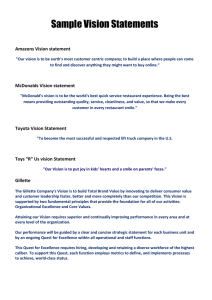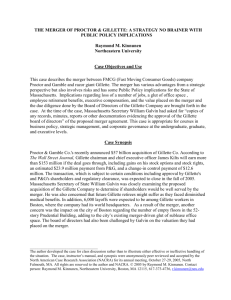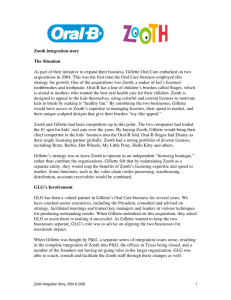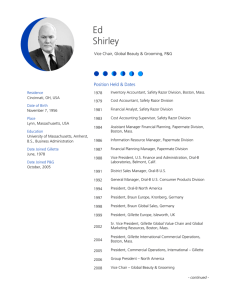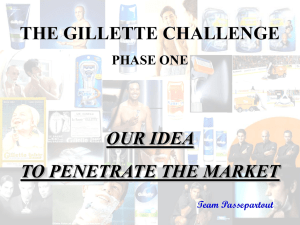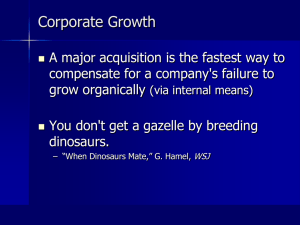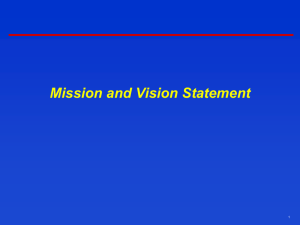A post graduate in Psychology, Chitra Ram currently works with
advertisement
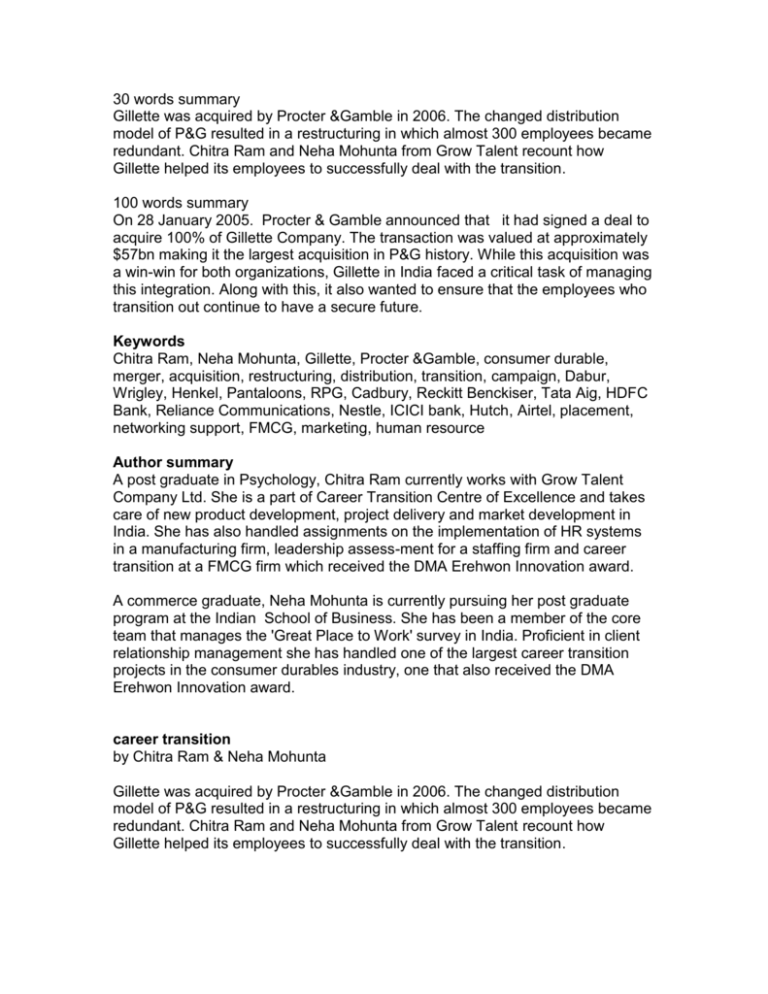
30 words summary Gillette was acquired by Procter &Gamble in 2006. The changed distribution model of P&G resulted in a restructuring in which almost 300 employees became redundant. Chitra Ram and Neha Mohunta from Grow Talent recount how Gillette helped its employees to successfully deal with the transition. 100 words summary On 28 January 2005. Procter & Gamble announced that it had signed a deal to acquire 100% of Gillette Company. The transaction was valued at approximately $57bn making it the largest acquisition in P&G history. While this acquisition was a win-win for both organizations, Gillette in India faced a critical task of managing this integration. Along with this, it also wanted to ensure that the employees who transition out continue to have a secure future. Keywords Chitra Ram, Neha Mohunta, Gillette, Procter &Gamble, consumer durable, merger, acquisition, restructuring, distribution, transition, campaign, Dabur, Wrigley, Henkel, Pantaloons, RPG, Cadbury, Reckitt Benckiser, Tata Aig, HDFC Bank, Reliance Communications, Nestle, ICICI bank, Hutch, Airtel, placement, networking support, FMCG, marketing, human resource Author summary A post graduate in Psychology, Chitra Ram currently works with Grow Talent Company Ltd. She is a part of Career Transition Centre of Excellence and takes care of new product development, project delivery and market development in India. She has also handled assignments on the implementation of HR systems in a manufacturing firm, leadership assess-ment for a staffing firm and career transition at a FMCG firm which received the DMA Erehwon Innovation award. A commerce graduate, Neha Mohunta is currently pursuing her post graduate program at the Indian School of Business. She has been a member of the core team that manages the 'Great Place to Work' survey in India. Proficient in client relationship management she has handled one of the largest career transition projects in the consumer durables industry, one that also received the DMA Erehwon Innovation award. career transition by Chitra Ram & Neha Mohunta Gillette was acquired by Procter &Gamble in 2006. The changed distribution model of P&G resulted in a restructuring in which almost 300 employees became redundant. Chitra Ram and Neha Mohunta from Grow Talent recount how Gillette helped its employees to successfully deal with the transition. On 28 January 2005. Procter & Gamble announced that it had signed a deal to acquire 100% of Gillette Company. The transaction was valued at approximately $57bn making it the largest acquisition in P&G history. While this acquisition was a win-win for both organizations, Gillette in India faced a critical task of managing this integration. Along with this, it also wanted to ensure that the employees who transition out continue to have a secure future. a bit of history For over a hundred years, Gillette has been known to transform innovative ideas into consumer products that engender strong and enduring consumer brand loyalty around the world. The company employed nearly 30,000 people globally and operated 31 manufacturing plants across fourteen countries. In India alone, Gillette had a turnover of Rs. 4.32bn (432) crores with a CAGR of 20%. Gillette was the market leader in male grooming, a category that includes blades, razors and shaving preparations. Gillette also held a strong position worldwide in select female grooming products, such as wet shaving products and hair epilating devices. In addition, the company held the world leader position in alkaline batteries and was recognized for its Oral-B in manual and power toothbrushes. The combination of Gillette and P&G, the two best-in-class consumer products companies created a stronger brand portfolio, opportunities for further innovation, faster sales growth, cost savings and revenue synergies. This acquisition was unique because both the companies: n were built on leadership brands. P&G portfolio had brands worth $16bn. Gillette brought five more and created a stronger portfolio of $21bn worth brands. n had a strong heritage of innovation to delight consumers. n had global scale with their products being marketed around the world. n placed a high priority on growth in developing markets. n had complementary expertise in health and personal care. integration dilemma As a consequence of the acquisition, a decision was taken to design a best-in-class and most cost effective sales and distribution model for India. P&G in India followed a different "go to market" model which is their "golden eye distributor model". In this model, the organization operates through thirty key distributors across India. Sales officers were not on the rolls of the organization but were a part of the distributor's team. All retail outlets were approached by the distributors directly. Gillette on the other hand, operated through a direct front line field force approach. Sales officers of Gillette were on the pay rolls of the company. Unlike the P&G structure, Gillette worked with almost 700 distributors. As a part of the integration, the company decided to operate through the 'golden eye' distributor model. This resulted in restructuring which meant that close to 700 distributors had to be disengaged and the roles of close to 190 employees became redundant. These employees essentially comprised of territory sales in-charge and area sales managers' from the four divisions - north, south, east and west. Gillette was also known to be a world class employer where employees enjoy an enriching work environment, it was even ranked 10th in the "Best Employer Survey 2003". Both organizations were a benchmark in the space of employee satisfaction. Gillette wanted to ensure that the employees who had to transition out continue to have a secure future, and made every plausible effort towards the same. Over and above the severance package that Gillette provided it engaged in providing transition support. Gillette also wanted to ensure minimum impact on the business and successful distributor disengagement. a helping hand While Gillette globally signed a contract with Right Management Consultants to provide career transition services, the challenges that Gillette faced in India were unique to the Indian context. The project was handled in India by the Indian partner of Right Management: Grow Talent. key observations: The key challenges were to help employees gain back their confidence, build capability and prepare them to face the job market. A shift in focus to realize personal vision was required. 60% of the employees had started their career with Gillette and the rest had spent a reasonably long tenure. Most had not attended a job interview in years. There was a high level of anxiety to secure a new job as soon as possible. The employees had to be kept motivated during their remaining tenure so as to ensure successful completion of the task at hand: distributor disengagement. engagement model: Career Transition Support was provided to the employees using 'Right methodology'. The model of Zeroing In Process (ZIP) was used. coaching line manager's workshop The ZIP process was preceded by a coaching line manager's workshop. This was organized for the supervisors/managers of the affected territory sales in-charges' and intended to provide a guideline to help managers to: n plan and conduct the separation meetings n handle employee reactions n manage employees during the transition process, keeping in view that they still had to disengage the distributors successfully with minimum impact on the business and n support the re-employment campaign workshop output Keeping these in mind career transition support was customized for the impacted employees and it included emotional support, intellectual support and landing support in the following ways: n emotional support: self positioning was done to help the employee manage the change around job loss. Further, employees were counseled on how to communicate the news to their family, friends and relatives. It also prepared the mana-gers to deal with placement consultants/friends who approached them with new opportunities. The best part was it helped managers to develop a ‘thirty second commercial' - a brief introduction of himself n landing support: managers strengths and skills were analyzed to help determine career directions and career assessment. Psycho-metric analyses were conducted to provide valuable insights which were then used for development purposes which helped a manager to improve his performance. These analyses provided feedback on an individual's leadership skills, influencing skills, problem solving ability, execution skills, interpersonal skills, time management skills and personal organization skills. Further the process also identified areas of development to act as a platform for undertaking skill enhancement workshops. e-learning initiatives were introduced and employees were given access to 'Right from Home' web link. Managers were also provided help in writing effective resumes and plan a 'personal marketing campaign'. n intellectual support: Managers were coached to improve their marketability. The program enabled candidates to identify their network and understand how to leverage the same. Managers were encouraged to work closely with placement companies in assisting the impacted employee in job search. Managers were prepared for interviews, salary negotiations and taking job decisions. They were also encouraged to use their strengths effectively and remove personal blocks to become successful in the next organization. To facilitate this, ten workshops were conducted across four locations in India. In addition one-on-one coaching support was made available on an individual need basis. workshop output Completed résumés were ready for circulation. Managers were well equipped with self marketing plans to approach the visible and hidden job market and were given hands-on practice to handle interviews. There was also a provision of feedback on each résumé and a coach was assigned for each candidate In addition to the program offerings of Right Management Consultants, Grow Talent also introduced the 'career fair' practice and 'placement and networking' support in India. career fair It was organized with an objective to help man other organizations with Gillette's highly competent talent pool that had to be outplaced. Structured programs were designed in partnership with Gillette and close to 37 best employers were contacted in India, across various sectors such as FMCG, banking, insurance, retail and telecom to ascertain their hiring requirements. Interested organizations were invited to the career fair which provided the prospective employers an opportunity to acquire high caliber talent at zero cost of hiring in a short time frame. A three day career fair was held across four locations wherein 23 companies and 190 employees interacted under one roof. Orga-nizations conducted interviews with the candidates, made spot offers and employees had to confirm their intention of joining. Organizations that participated in the career fair included companies such as Dabur, Wrigley, Henkel, Pantaloons, RPG, Cadbury, Reckitt Benckiser, Tata Aig, HDFC Bank, Reliance Communications, Nestle, ICICI bank, Hutch and Airtel. placement and networking support Placement agencies were identified, which had opportunities that the territory sales in-charge and area sales managers could explore. There were certain companies which could not participate in the career fair and networking support was extended by ascertaining the requirements of such organizations. Résumés of the candidates were shared with them and prospective employers were brought into contact with the candidates. A survey was conducted to identify the causes which were acting as road blocks in securing a new job. Analysis of the results helped identify areas of development and with that as a basis, workshops were conducted to overcome such barriers. critical success factors The critical factors that acted as enablers in making this initiative a success were: 01 open communication: Gillette ensured that at each stage the employees were kept informed. The employees were given a rationale behind the business decision and they were regularly updated with information about the steps the organization would take to ensure a secure future for them, updates on when the workshops were being organized, the companies contacted for the career fair, kind of opportunities in the market, placement consultants in the market etc. 02 trust: The employees had a high degree of trust on the manage-ment. The management was found to be approachable and accessible. The employees were confident that the management would keep the best interest of the employees in mind. 03 counseling: The leaders - be it business leaders, area sales managers or HR; both at the corporate and divisional level provided tremendous support to their teams. Over and above the Grow Talent consultants who were accessible to each and every employee and the internal mentors at Gillette played a critical role in guiding employees to make right career choices, in dealing with anxiety, handling the transition news with friends and family. Even at the peer level despite the pressure, employees supported one another wholeheartedly. It truly reflected the organization culture that Gillette had build over the years. It seemed to operate like a family with members looking out for each other. Former Gillette employees who heard the news of the transition were gladly willing to counsel, guide and even look for opportunities that the transitioning employees could take up in their organization. 04 management commitment to outplacement: The initiative was one of the first of its kind in the FMCG world. Although with no benchmarks to guide it, Gillette was committed to ensuring that the employees well prepared for the future. They also wanted to ensure that majority of the employees had at least one job offer in hand when they left the organization. They set an internal target for themselves - at least 80% land in new opportunities. Much like other targets that Gillette often succeeded in achieving and exceeding, the management drove this project aggressively and with utmost levels of commitment. For this all senior members of the management personally pitched in inviting organizations for the career fair, counseling employees, addressing all queries, networking for opportunities for the candidates and en-couraging employees by making them realize their market value (while being realistic). 05 unique partnership between client and consultant: The relationship that Grow Talent and Gillette enjoyed was one built on trust, transparency and commitment. At each stage both were synchronized and equally committed in arriving at the best results for the transitioning employees. Consultants stationed themselves at the Gillette corporate office itself and were often mistaken as Gillette employees. The drive, empathy and enthusiasm at crossing each mile-stone or undertaking key initiatives were reflected by both client and consultant. outcome of career transition at Gillette The career transition support enabled and prepared employees to face the job market. While the career fair acted as a catalyst, people who did not find suitable opportunities were supported right till the end through placement agencies, networks etc. The end result was n for the employees: There was 100% placement. Employees were placed with blue chip companies with higher salaries: average salary increase being approximately 29% and close to 35%. They also joined at higher levels of responsibility. This in turn created a league of strong brand ambassadors for Gillette. For the organization, this process enabled seamless transition to best-in-class model, ahead of its time. Satisfied employees and distributors; All 700 distributors settled two months ahead of plan with no litigations. There was No loss to business momentum. Career transition at Gillette India was quoted as one of the best transitions handled within Gillette globally. The career fair practice was leveraged in other geographies. To summarize, the initiative created a win-win for all stakeholders and set a fine example in today's dynamic business environment preparing HR professionals for challenges that they are likely to face in the future. It further goes to show that HR no longer plays a dormant role and is emerging as a strategic business partner where key initiatives undertaken have significant business impact. n.
